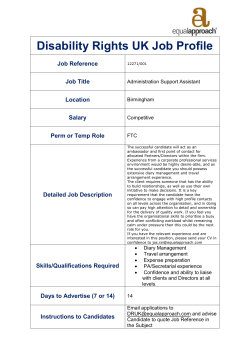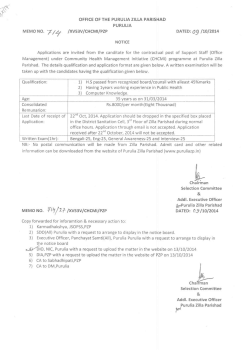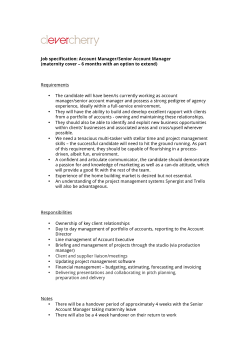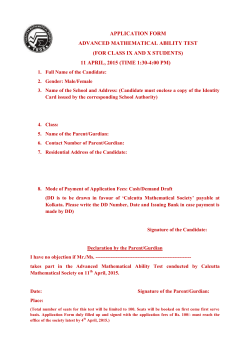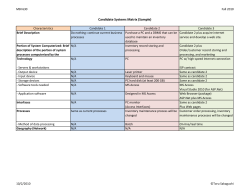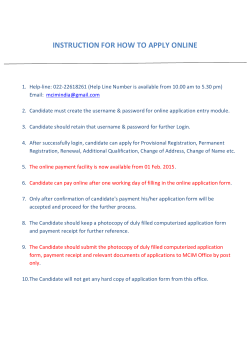
A Method for Service Identification from Business Process
A Method for Service Identification from Business
Process Models in a SOA Approach
Leonardo Guerreiro Azevedo1,2, Flávia Santoro1,2, Fernanda Baião1,2, Jairo Souza1,
Kate Revoredo1, Vinícios Pereira1, and Isolda Herlain3
1
2
NP2Tec – Research and Practice Group in Information Technology
Departament of Applied Informatics, Federal University of the State of Rio de Janeiro
3
Petrobras – Petróleo Brasileiro S/A
{azevedo, flavia.santoro, fernanda.baiao}@uniriotec.br,
{jairofsouza, katerevoredo,viniciospereira}@gmail.com,
iherlain.POLITEC@petrobras.com.br
Abstract. Various approaches for services development in SOA propose business processes as a starting point. However, there is a lack of systematic methods for services identification during business analysis. We believe that there
has to exist a integrated view of organizational business processes to promote
an effective SOA approach, which will improve IS requirements understanding.
In this context, we propose a method, and a detailed set of activities, for guiding
the service designer in identifying the most appropriate set of services to support organization business activities. The method was applied in a real scenario
of a Brazilian Petroleum organization.
Keywords: Service Identification, Business Process Model, Service Life-cycle.
1 Introduction
The deployment of SOA (Service-Oriented Architecture) in an organization presents a
series of challenges. As new architectural roles and development tasks were introduced by the service-oriented approach, the life-cycle model of traditional software
engineering may not be directly applied.
The need for an approach for service development is recognized by several authors,
who also agree that services should be defined according to organizational business
processes and their corresponding models [1][2][3][4][6][7][8]. These works, however, do not present detailed methods for business analysis towards services identification and, very commonly, propose principles or guidelines that are very difficult to
follow in practice due to the lack of systematic process. Moreover, they do not explicitly consider the role of the system designer, which in practice is responsible for aligning the service development demands to the actual organization scenario (strategic
objectives and goals, current demands, amount of available resources), thus turning
the service identification activity into a complex decision-making process. Yet,
related works are typically proposed in domains where business processes are
T. Halpin et al. (Eds.): BPMDS 2009 and EMMSAD 2009, LNBIP 29, pp. 99–112, 2009.
© Springer-Verlag Berlin Heidelberg 2009
100
L.G. Azevedo et al.
automated and services may be directly derived from them. In real scenarios, however, automated activities are mixed with manual or system-supported ones, all in the
same process. Also, the same activity may appear in several processes in the organization, being implemented or supported by several information systems, in different
departments of the organization. We believe that there has to be an integrated view of
the organizational business processes, where each process is derived from the organizational key-value chain. This integrated view means the relationship among processes (and consequently their models) are explicit, since they are part of a common
process repository, they are linked to each other through interface elements and they
share global artifacts such as clusters of data, business rules and business requirements. This infrastructure makes possible a SOA analysis on business process to
know about commonalities (common element definitions) and interfaces (execution
and derivation relationships) among processes. This view must be considered to
choose which processes should not/be automated, and is determinant for an effective
service identification approach. In the process repository, it is possible to create an
explicit link between business processes’ constructs and candidate services and physical (implemented) services descriptions. So, it makes easier to identify which services
must be updated when business process changes, and vice-versa. So, evolution of the
services themselves can trigger evolution of the supporting business processes, and
following the link it is possible to track changes.
This paper proposes a top-down method for systematic service identification from
business process models. Our main contribution relies on a set of heuristics that were
validated in a real scenario. The results of a case study are presented.
2 Service Life-Cycle
Services life-cycle models present some additional challenges when compared to traditional software engineering, for example: it is even more important to align business
requirements with service-based IT solutions; typical distributed service development
scenarios requires more complex security constraints; and handling service versioning
to accommodate business changes is an essential issue. Thus, a pre-defined life-cycle
model for organizational services is vital for the smooth operation of SOA [12].
Gu and Lago [4] claim that there is no consensus for a service life-cycle model in
the literature. They evaluated a number of proposals and pointed to a well-defined
sequence of steps divided into three phases: design time, run time and change time.
Services identification is not handled explicitly, even though it is essential for service
modeling. On the other hand, the service modeling step must be presented along with
a set of step-by-step instructions [6]. Arsanjani [1] proposes the use of business process modeling in SOMA methodology. However, it is not proposed a systematic approach for service identification from business process. The same lack of systematic
approach appears in [3] [7] [8][9] [10] and [11]. Klose et al [7] and Papazoglou and
Heuvel [11] presented some principles that should be observed during services identification (e.g, low coupling, high cohesion and high level of granularity), while Marks
and Bell [9] emphasized use/reuse of services. Mcbride [10] proposes scanning a
A Method for Service Identification from Business Process Models
101
repository of business requirements and look for: services that meet this requirement;
services that could be adapted to meet it; or a new service that should be implemented.
The approach of Jamshidi et al. [5] considers both an enterprise business process
model and an enterprise entity model and proposes an approach for identifying and
specifying enterprise software services. The approach assumes that the business process model is highly detailed (up to the level of elementary business process, or EBP)
and that the granularity of each business entity is the same of the EBP which creates it.
Process models in such a level of abstraction are not easy to accomplish. Besides, this
proposal does not consider process model elements (business rules, business requirements, process flows). So, finding the service which meets a specific business requirement is totally dependent on the SOA analyst expertise and memory, and there is a lack
of systematic methods for services identification during business analysis.
3 A Service Identification Method from Business Process Models
This section presents a method for identifying candidate services from a set of business processes models considered as input. Erl [2] defines a candidate service as an
abstract (not implemented) service which, during the design phase of a service lifecycle model, could be chosen to be implemented as a service or as an application
function. We further define 2 types of candidate services, namely: candidate data
service, which is a service that performs CRUD (Create, Retrieve, Update and Delete)
operations on databases; and candidate business service, which is a service that performs business rules which are not so related to CRUD operations. The method includes the phases presented in Figure 1.
Service identification starts when a demand for software development is received.
The demand is represented as a set of requirements to be implemented (either as services or application functions). Other entries for the method are: “to-be process”
models (designed processes in which the new requirements are already represented),
and a set of business requirements already implemented in existing applications. The
to-be process models are used for identification and classification of candidate services, while the business requirements of existing systems and the business requirements of the demand are used for consolidation of candidate services. The method
returns a set of elements (tables, charts, services dependency graph) that should assist
the service designer in making decisions about the most suitable implementation for
an identified candidate service. In other words, the output of our proposal is a set of
candidate services that is input for the next steps in a service life-cycle model (for
example, service analysis and design). In these steps, the designer will decide if a
candidate service is implemented as a physical service or if it must be considered as
part of another service or if it must be discarded for implementation.
Selection of activities
Identification and classification
of candidate services
Fig. 1. Method for Service Identification
Consolidation of candidate
services
Consumo
das
UPGNs
registrado
Realizar
fechamento
mensal d...
Consumo
das
correntes
registrado
Registrar
consumo das
correntes
Automatic
SYS
Consumo
das UFluidos
registrado
Registrar
consumo das
U-Fluidos
Produção
das
correntes,
UPGN'...
Produção de
C5+ não
identificada
Registrar
consumo das
UPGNs
Verificar
produção de
C5+ a consumir
Produção de
C5+
identificada
Produção de
óleo
identificada
Verificar
produção de
óleo a consumir
Selection of
activities
Automatable
Produção de
óleo não
identificada
Produção
diária
disponível
Produção
das
UPGNs
registrada
Produção
das UFluidos
registrada
Registrar
produção das
U-Fluidos
Produção
diária das
U-Fluidos
disponível
Produção
das
correntes
disponível
Produção
das
concessõe
s...
Produção
das
correntes
registrada
MCCP
Verificar
registros de
produção
necessários
Controlador da
produção
Registrar
produção das
UPGNs
L.G. Azevedo et al.
Registrar
produção das
correntes
102
Partially supported
by systems
Fig. 2. Selection of Activities Phase
3.1 Phase 1: Selection of Activities
In the first phase (Figure 2), a set of activities are selected from to-be business process
models. A process activity is selected if it is either automatic (performed entirely by a
system with no manual interference), partially supported by systems or automatable
(manually executed, but expected to be supported by a system). Manual activities
(i.e., the ones that are not being considered for automation) are not selected, since it
makes no sense to develop services for them.
3.2 Phase 2: Identification and Classification of Candidate Services
In the second phase (Figure 3), candidate services are identified by applying a set of
proposed heuristics to the set of activities selected in phase 1. The proposed heuristics
were defined in order to address both syntactical and semantic analysis of the process
model.
Syntactical (structural) analysis of process models is carried out by considering the
process model structure. Thus, we propose heuristics for service identification from
each workflow pattern proposed in [13] [17]. A workflow pattern is the abstraction of
a concrete form that remains repeatedly in specific contexts. The set of workflow
patterns from [13] and [17] is often used as a benchmark for workflow management
systems functionality. When relying on the workflow patterns specification for service identification, we assure covering all possible flow of activities that may be represented by a process model.
The semantic analysis of a process model towards service identification should
consider all indications for process (total or partial) automation. Among all possible
elements in a process model [15], it seemed obvious to address both “business requirement” and “business rule” elements in special, since their semantic indicates
functionalities that should be implemented by a process-supporting service. Thus, we
propose heuristics for service identification from each of these two elements, when it
is associated to some of the activities selected from phase 1.
Identification and classification
of candidate services
Automatic
SYS
Automatable
Partially supported
by systems
Workflow patterns Activities
(structure)
(semantics)
MCCP
Programador da
produção
Ordem de
produção
Liberar ordens de
produção
planejadas
Ordem de produção
SAP-PP
Ordem de
produção
COHVOMPP
Liberação de ordens
de produção
Fig. 3. Identification and Classification Phase
Candidate data
service
Candidate
business service
A Method for Service Identification from Business Process Models
103
Candidate service
Sequence of automated
activities
Fig. 4. Example of candidate service from a series of sequential activities
After being identified, each candidate service is classified (data, business or utility)
according to its characteristics, i.e, if the service performs CRUD operations on databases or if it is a service that performs business rules; and utility service, which is a
generalized service whose operations can be used in different context adjusting some
of its parameters.
The following heuristics handle semantic analysis:
Heuristic 1 (Business Rule): A candidate service must be identified from a business
rule.
Example: From the business rule "Select product supplier", described as "The selected supplier should be the one with the lowest price for the requested amount of
product”; the candidate service Select product supplier must be identified. The
candidate service has the same description than the rule from which it was identified.
Heuristic 2 (Business Requirement): A candidate service must be identified from a
business requirement.
For example, from the business requirement "Retrieve quotes from suppliers", described as “The system ABC should retrieve prices of all suppliers who supply a certain product"; the candidate service "Retrieve quotes from suppliers" is identified.
The candidate service description is the same of the requirement from which it was
identified.
The following heuristics handle syntactical analysis:
Heuristic 3 (Sequence of Activities): A candidate service must be identified from a
series of sequential activities.
For example, from the sequence of automated activities "Commit credit limit",
"Determine the investment rate charged" and "Generate contract" (Figure 4), a
candidate service must be identified.
Heuristic 4 (AND): A service candidate must be identified from an AND-pattern.
AND-pattern is a structure started in a point in the workflow where a single flow is
divided into multiple streams, which can run in parallel, and finalized at a point in the
workflow where multiple parallel streams converge into a single flow, synchronizing
them, or where branches end in final event [17]. For example, a service candidate
must be identified from the AND-pattern presented in Figure 5, for activities "Get
customer's history", "Get financial information" and "Get information from stealing
and robbery".
Heuristic 5 (XOR): A service candidate must be identified from a XOR-pattern.
XOR-pattern is a structure started in a point in the workflow where, based on a decision, one and only one of several branches of the flow is chosen, and finalized at a
104
L.G. Azevedo et al.
Out of date
customer
information
Get
customer's
history
Get financial
information
Update
customer
information
Get information
from stealing
Verify customer
information
Customer
's history
obtained
Finantial
information
obtained
New customer
information
Stealing
information
obtained
Updated
customer
information
Fig. 5. Example of AND
Fig. 6. Example of XOR
point in the workflow where the ramifications of the flow come together without
synchronization or when one or more of the ramifications ends in final event [17]. For
example, a service candidate must be identified from the XOR-pattern of Figure 6.
Heuristic 6 (OR): A candidate service must be identified from an OR-pattern.
OR-pattern is a structure started in a point in the workflow where, based on a decision, one or more branches of the flow is chosen and ended at a point in the workflow
where the various branches of the flow are joint. If more than one of the source
streams was implemented, then it is necessary to synchronize them. Ramifications
may also end in a final event [17].
Heuristic 7 (Loop): A candidate service must be identified from a Loop-pattern.
Loop-pattern is a structure of workflow where one or more activities can be performed repeatedly.
Heuristic 8 (Process Interface): Candidate services must be identified from the interaction between two processes: one candidate service to pass the information to the
other process, and another service to receive the message.
Process interface is the representation of the mechanism that one process passes the
flow to another process [15]. For example, in Figure 7, when the process “Treat store
limit” (Figure 7a) identifies that the threshold of a commodity store was reached, it
sends a request for goods to the process “Provide goods” (Figure 7b). In this case, a
candidate service must be identified (in process “Verify stock level”, Figure 7a) to
pass the requirement for stock replenishment to the process “Process product order”.
On the other hand, another candidate service must be identified (in the process “Process product order”, Figure 7b) to receive the request for stock replenishment and start
to process product order.
Heuristic 9 (Multi-Instance Activity): Candidate services must be identified from a
multi-instance activity: one candidate service to send the information to each instance
of the multi-instance activity; one candidate service to represent each instance of the
multi-instance activity; and, one candidate service to consolidate the outputs of the
instances and to pass the result to the next step.
A multiple-instance task is a task that may have multiple distinct execution instances running concurrently within the same workflow case. Each of these instances
executes independently. Only when a nominated number of these instances have
completed, the task following the multiple instance task is initiated [13].
A Method for Service Identification from Business Process Models
Send request
for goods
Required
stock
replenishm
ent
Process
product
order
Verify stock
level
Required
stock
replenishm
ent
(a)
105
Receive
request for
goods
(b)
Fig. 7. Example of process interface service
Heuristic 9 is in accordance with patterns proposed in [13]. We propose: a sender
service which is known as a broker and it is responsible for distributing the messages
to each instance; a candidate service responsible for operating the rules and requirements described on the multi-instance activity; and, a candidate service to consolidate
the outputs of each instance and pass the result to the next step.
3.3 Phase 3: Consolidation of Candidate Services
In the third phase, information about candidate services is consolidated. Service consolidation aims at gathering several characteristics about each candidate service so as
to support the service designer in deciding upon its implementation. Services not
selected to be implemented are removed, resulting in a refined candidate services list.
The proposed heuristics for service consolidation were based on the principles for
high-quality service implementation mentioned in [1][2][5][6][7][8][9][11], thus
reflecting the most important technical issues that should be observed by designers.
Moreover, information regarding the candidate service usage (by process activities or
other candidate services) and existing implementations are also considered.
However, we did not try to automatically select the candidate services to be implemented, since this is a very complex and subjective decision, influenced by not
only technical but also political and cultural organizational objectives. We argue that
with the information produced in this phase, the designer has more knowledge for
deciding upon service implementation. The following heuristics are proposed:
Heuristic 10 (Service Reuse Degree): The degree of reuse of a candidate service is
calculated by the sum of times the service is used by each process activity.
Service reuse corresponds to the number of occurrences of the activities from
which the service was identified. The degree of reuse cannot be automatically calculated when a candidate service was identified from a multi-instance activity, in which
the iteration granularity is not quantitatively represented (e.g., an activity that should
be executed “for all company units”).
Heuristic 11 (Link Candidate Service and System): A candidate service identified
from a business requirement that is already implemented should be associated to the
systems which implement it.
This should help in the design phase to identify which requirements are already
implemented and could be exposed as services.
Heuristic 12 (Link Candidate Service and Demand Requirements): A candidate
service identified from a business requirement of the demand must be associated to it.
106
L.G. Azevedo et al.
A candidate service identified from the demand should be associated with its corresponding requirement. That information will allow the designer to identify the
minimum set of services required to meet initial demand, or for prioritization.
Heuristic 13 (Link Candidate Service and Activities): A candidate service must be
associated to the activities from which it was identified.
This enables the service designer to know all the services used by a process activity, or all the activities supported by (impacted by) a service. This information may be
used in the future for choosing a unique service implementation that encapsulates all
the identified functionalities indentified in the activity(ies).
Heuristic 14 (Identify Candidate Services Dependencies): A candidate service
must be associated to other service candidates that use it.
This information is obtained from the association between business rule × business
rule and business rule × business requirement, when they are explicit in modeling.
The relationships allow the identification of the granularity of candidate services as
well as the dependency between them. The candidate services that do not use any
other candidate services are considered fine-grained, and are independent from other
services, i.e., they are self-contained. The services that use other services are coarsergrained services. They depend on services they use. The more dependencies a service
has, the higher is the susceptibility to failures.
Heuristic 15 (Utility Candidate Service Identification): A utility candidate service
shall be identified from the observation of recurrent patterns.
Our previous experience in service development led us to pay a special attention
to some recurrent flows of activities which are very typical in different processes
of the same organization, or even in different organizations. Some of those domain-independent recurrent patterns were pointed by [16]. Thus, we also propose
heuristics for service identification from recurrent patterns. The rationale for using
recurrent patterns for service identification is that, once a pattern is detected in a
process model instance, its corresponding service will probably be highly reused.
Hence it is related to one of the main principles of service, which is “reuse”. A
service that is indentified from a recurrent flow is marked as a “Utility Candidate
Service”.
The method final product is the list of candidate services (with descriptions) as
well as a table containing a series of information useful for service designers. Besides
a dependency graph also assists the designer to make decisions about the implementing services. Next section describes a case study in a real scenario.
4 Applying the Proposed Method for Service Identification in a
Real Scenario for Oil Production Diagnosis
The method proposed in Section 3 was experimented in a case study conducted at
PETROBRAS, the largest Oil Company from Brazil. PETROBRAS is responsible for
the majority of Oil and Gas derivatives exploration and production in this country. The
A Method for Service Identification from Business Process Models
PI
Diary
SOLAR
Diagnose
OP
Supply
sensor
information
Production
and stock
information
stored
Production
diagnose
required
107
Get day
accumulated net
production of
measuremen...
Analyze oil
production
conditions of
Calculate day
predicted net
production of
measureme...
Fig. 8. EPC of “Send physical sensor information” process
case study was done in the “Diagnose daily oil production” business process model.
Production Control is an important process within the Exploration and Production
(E&P) area of PETROBRAS.
The “Diagnose daily oil production” is a to-be process model. The process was designed in detail, so that business users and application developers’ needs were met.
The designed model comprises 19 activities, control flows, 90 business rules and 37
business requirements. The process aims at maximizing company results. This is
achieved using real time physical sensor information to fast and accurately identify
the production variation related to previous oil production information (production of
previous days or previous month). This process has two subprocesses: “Send physical
sensor information” and “Analyze oil production conditions of measurement node”.
Each process was detailed using EPC (Event-Driven Process Chain) diagrams and
each process activity was detailed using an FAD (Function Allocation Diagram) [14].
Figure 8 illustrates the EPC of “Send physical sensor information” process. Figure 9
presents the FAD of the “Supply sensor information” activity, where business rules
(i.e., “Stocks of non-automatic tanks”) and business requirements (i.e., “Supply tank
stock information”) are also presented.
The service identification method takes as its inputs: (a) a set of to-be process
models: for this experiment, it corresponds to “Diagnose daily oil production”; (b)
a set of system requirements already implemented in applications: in this case, it is
represented by an empty set, since it is a new business process, and there is no
application supporting it; (c) a demand, i.e., a set of business requirements to be
implemented: in this experiment, all business requirements were considered
demand.
Phase 1 (Activity selection): all automatic, subject to automation, and partially supported by computers activities were selected, such as: Supply sensor information; Get
accumulated measurement node net production from previous days; Calculate measurement node predicted net production for the day; Analyze characteristics of
measurement node production; Query measurement node previous productions; etc.
Phase 2 (Candidate service identification and classification): candidate services
were identified and grouped accordingly the proposed heuristics. Each service was
108
L.G. Azevedo et al.
PI
Previous day
production of
measurment
node
Tank stock
of
measurment
node
Previous day
production of
measurment
node
Supply
sensor
information
Tank stock
of
measurment
node
Stocks of
non-automatic
tanks
Supply tank
stock
information
Get tank stocks of
measurement node
Measurement node
net production of
previus day
Supply
measurment
node net
production
Fig. 9. “Supply sensor information” activity’s FAD
described with the following attributes: service name; service type (candidate business or candidate data service); input and output information; which element originates the service (business rule, business requirement, activity flow); activities where
it was discovered from; service description. Table 1 and Table 2 present examples of
candidate services. The experiments did not identify candidate services using heuristics 7 and 9 since there is no loop or multi-instance activity in the model.
Phase 3 (Candidate services consolidation): The results of this phase are presented in
Table 3 and Table 4. Table 3 presents information related to Heuristic 10 (Service Reuse
Degree), Heuristic 11 (Link Candidate Service and System) and Heuristic 12 (Link Candidate Service and Demand Requirements). It was identified 72% of candidate business
services and 28% candidate data services. No candidate utility services were identified.
Table 1. Examples of service candidate information
Attributes
Heuristic
Name
Type
Input
Output
Source
Service 1
Heuristic 1
Calculate measurement node production
of type appropriation of Estreito
Business service
Measurement node
Measurement node oil production
Business rule: “Production calculus of
appropriation measurement node of
Estreito to be analyzed”
Send sensor information
Service 2
Heuristic 2
Query measurement node
tank information
Data service
Measurement node
Asset code, measurement
node name, oil stock
volume in the tank in the
end of the day
Business requirement:
“Supply information
about tank oil stock”
Supply sensor information
Service 3
Heuristic 3
Calculate predicted net
production
Business service
Measurement node
Production variation of
measurement node
Workflow pattern
Get accumulated
measurement node net
production; Calculate daily
predicted net production of
measurement node
Description Production of Estreito measurement node Asset code, measurement Get accumulated
to be analyzed = Production of measure- node name, stock volume measurement node net
ment node of Estreito B –
of oil in the tank in the
production, and then calcuProduction of fiscal measurement node of end of the day from Plant late daily predicted net
Angico – Production of fiscal measurement Information System
production of measurement
node A – Production of fiscal
node
measurement node B.
Activities
A Method for Service Identification from Business Process Models
109
Table 2. Examples of service candidate information
Attributes
Service 4
Service 5
Heuristic
Heuristic 4
Heuristic 5
Analyze production of measurement node View production ATP
Name
diagnose summary
Business service
Business service
Type
Measurement node
Measurement node
Input
Loss of measurement node production
Output
Workflow pattern
Workflow pattern
Source
Analyze loss of production; Analyze
View production diagnose
Activities
production potential variation of
summary;
measurement node; identify
View diagnose summary
measurement node oil well that start to
produce; Analyze tank oil stock
information
Description Analyze measurement node production
calculating loss of production, potential
variation of production, identify
measurement node oil well that start to
produce; Analyze tank oil stock
View production diagnose
summary measurement
node
Service 6
Heuristic 6
View production diagnose
summary
Business service
Measurement node
Workflow pattern
View production diagnose
summary; Analyze loss of
measurement node
production; Analyze
production potential
variation of measurement
node; analyze measurement
node oil well that start to
produce; Analyze tank oil
stock information
View production diagnose
summary of measurement
node
Table 3. Table presents reuse, systems those implement candidate service functionality and
association between candidate services and demand
Candidate service
Type
Calculate measurement node production
of type appropriation of Estreito
Calculate daily predicted net production
of measurement node
Business
Business
Query
measurement
production diagnose
Data
nodes
for
Reuse
Demand’s requirements
1
Implem.
Req.
-
1
-
1
-
Calculate daily predicted net
production of measurement
nodes
Supply measurement node
net production information
Table 4 presents the association between candidate services and activities, according to Heuristic 13 (Link Candidate Service and Activities). This information can be
used to identify all services those were discovered from the same activity, which can
originate one logical service that encapsulates all those functionalities.
S1
Table 4. Candidate services and activities association
Candidate service
Calculate difference between daily predicted
net production related to previous month
Calculate difference between daily predicted
net production related to previous days
1
2
Activities
3
4
5
6
X
X
S2
S3
S4
Fig. 10. Dependency graph
of some candidate services
From Heuristic 14, dependency graphs can be built to represent dependencies between candidate services. Figure 10 presents an example of dependency graph. According to this example, the designer may choose to implement only one service
merging functionalities of services S2, S3 and S4 in service S1, or develop S1 invoking
(orchestrating) the others three services. This graph can be built for each service.
110
L.G. Azevedo et al.
Heuristic 15 is related to identify candidate services that represent activity patterns
based on recurrent functions or activity patterns based on organizational structural
aspects. In spite of the literature demonstrate that these patterns may occur in business
process, in our experiments they were not present.
The “Diagnose daily oil production” process has only 19 activities. This could
mean that there were only some candidate services. However, the heuristics identified
147 candidate services. Business rule and business requirement heuristics produced
57% and 30%, respectively. It is because that this business process has a lot of
business rules and business requirements, and it is strongly based on system.
The important aspect of our approach is that both fine-grained and coarse-grained
candidate services were identified. We observed that Heuristic 1 (Business Rule), in
general, produce fine-grained services, while Heuristic 2 (Business Requirement) and
workflow pattern heuristic (Heuristic 3 to 9) produce medium- to coarse-grained ones.
After the application of the method, the services identified were validated by the
specialists, i.e., System Analysts who developed physical services to support the
automation of “Diagnose daily oil production” business process. All services they
implemented were identified by our proposal; and the specialists agree that the consolidated information helped them in service implementation. One difference that
must be highlighted is that candidate services and implemented services have different granularities. For instance, the functionalities of five candidate services were
merged and implemented in only one physical service. Those five services correspond
to methods that manipulate the same entity. The specialists pointed that the identification of those candidate services by the proposed method helped them to know which
functionalities should be implemented as well as they would have more reuse if published in the same service. On the other hand, some candidate services where implemented and orchestrated in a higher level service. In this case, the specialists observed
that the functionalities would have more use and reuse if published separated. Besides, they observed that it also would be useful if the functionalities were published
as an orchestrated service according to a specific flow.
Hence the specialists confirmed that a method for service identification from business process models must identify candidate services and produce information that
can assist the service design phase. Hence the experiment demonstrated good results,
and pointed to the possibility of new heuristic for the design phase.
5 Conclusions and Future Work
The deployment of SOA in an organization presents a series of challenges, especially
service modeling, design, monitoring and management. Proposals for service lifecycle models are typically abstract and lack from considering the integrated view of
business processes in an organization. A service life-cycle not only facilitates the
management of service-oriented systems but can also improve its governance.
Among the activities of a service life-cycle model, we emphasize the services identification step. We propose a top-down approach for services identification from business process models, applying heuristics to define services from the semantic analysis
of process elements such as business rules and business requirements, and from a
syntactic analysis of process models according to its corresponding structural patterns.
A Method for Service Identification from Business Process Models
111
As a result, a set of candidate services is identified and scored according to a set of
criteria (degree of reuse, existing implementations, presence in the input development
demand, usage by process activities, relationship between services, and service granularity). This information helps service designer to better design and plan service
implementation, while also considering subjective issues such as security, political
decisions, and so on. Besides, an explicit link can be made between business process
constructs and services descriptions. Business process evolutions can target changes
in the services which support the process, and vice-versa. The association of services
and process models helps in tracking changes within the models that directly
impact IT, as well as changes in IT that should be reflected in the process models.
Furthermore, changes in processes can trigger calls or automatic changes in the
implementation of services.
The proposed method was assessed on a case study in a real organization. In this
case study, a process model for oil production diagnosis was used as input. The
method was manually applied, and resulted in 147 candidate services identified. We
are currently working on a supporting tool for the method.
As future work we are studying the next steps (analysis, design, implementation,
deployment and maintenance) and the changes on business process models resulting
from service life-cycle steps. Another important future work is related to service reuse
principle. A service can be reused in a variety of contexts. In other words, it can support different business process. So, a change in a business process can induce service
maintenance, and consequently impact another business process. The management of
these changes and business process impacts are important issues.
Acknowledgment
The authors thank Petrobras (TIC/TIC-E&P/GDIEP) for supporting this project.
References
1. Arsanjani, A.: Service-oriented modeling and architecture (2004),
http://www.ibm.com/developerworks/webservices/library/
ws-soa-design1/
2. Erl, T.: Service-Oriented Architecture: Concepts, Technology, and Design. Prentice Hall,
Englewood Cliffs (2005)
3. Fareghzadeh, N.: Service Identification Approach to SOA Development. In: Proceedings
of World Academy of Science, Engineering and Technology, vol. 35, pp. 258–266 (2008)
4. Gu, Q., Lago, P.: A Stakeholder-Driven Service Life Cycle Model for SOA. In: 2nd International Workshop on Service Oriented Software Engineering: in Conjunction with the 6th
ESEC/FSE Joint Meeting, pp. 1–7 (2007)
5. Jamshidi, P., Sharif, M., Mansour, S.: To Establish Enterprise Service Model from Enterprise Business Model. In: 2008 IEEE International Conference on Services Computing,
vol. 1, pp. 93–100 (2008)
6. Josuttis, N.M.: SOA in Practice: The Art of Distributed System Design. O’Reilly, Sebastopol (2007)
112
L.G. Azevedo et al.
7. Klose, K., Knackstedt, R., Beverungen, D.: Identification of Services - A Stakeholderbased Approach to SOA Development and its Application in the Area of Production Planning. In: ECIS 2007, pp. 1802–1814 (2007)
8. Klückmann, J.: 10 Steps to Business-Driven SOA, ARIS Expert Paper (2007),
http://www.ids-scheer.com/set/6473/
ARIS_Expert_Paper-SOA-10_Steps_to_SOA_Klueckmann_2007-03_en.pdf
9. Marks, E.A., Bell, M.: Service-Oriented Architecture: A Planning and Implementation
Guide for Business and Techonology. John Wiley & Sons Inc., Chichester (2006)
10. McBride, G.: The Role of SOA Quality Management in SOA Service Lifecycle Management. DeveloperWorks (2007),
ftp://ftp.software.ibm.com/software/rational/web/articles/
soa_quality.pdf
11. Papazoglou, M.P., Heuvel, W.-J.v.d.: Service-Oriented Design and Development Methodology. Int. Journal of Web Eng. and Tech. (IJWET) 2(4), 412–442 (2006)
12. Pulier, E., Taylor, H.: Understanding Enterprise SOA. Manning (2006)
13. Russell, N., ter Hofstede, A.H.M., Edmond, D., van der Aalst, W.M.P.: Workflow Data
Patterns. QUT Technical report, FIT-TR-2004-01, Queensland University of Technology,
Brisbane (2004)
14. Scheer, A.-W.: ARIS - Business Process Modelling. Springer, Berlin (2000)
15. Sharp, A., McDemortt, P.: Workflow Modeling: Tools for Process Improvement and Application Development. Artech House computing library (2001)
16. Thom, L., Iochpe, C., Reichert, M.: Workflow Patterns for Business Process Modeling. In:
8th Int. Workshop on Business Process Modeling, Development, and Support (BPMDS),
pp. 349–358 (2007)
17. Van der Aalst, W.M.P., Ter Hofstede, A.H.M., Kiepuszewski, B., Barros, A.P.: Workflow
patterns. Distributed and Parallel Databases 14, 5–51 (2003)
© Copyright 2025
